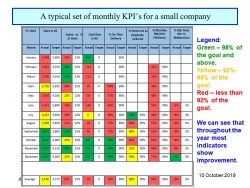Links to articles about KPIs can be found at the end of the article.
In the current series of articles, I focus on the important KPIs every business must monitor. I have already written many articles regarding this very important issue. However, this article focuses on concisely presented KPIs with links to learn about them in greater detail.
The first article in the series, which was published last week, discussed seven KPIs every CEO must examine once a week or once a month. Two additional KPIs that CEOs must address every time a deviation is reported
were presented: Quality Assurance and the law of Work & Rest hours.
Company managers are accountable for the various KPIs. CEOs are accountable for the company’s profit.
Personal responsibility and cooperation
Every manager is accountable for 3 to 4 KPIs. They are responsible for establishing the action plans and reaching the targets. At the same time, managers depend on each other’s performance and cooperation. To achieve the final goal of the business, CEOs must make sure that all managers work in harmony and in full cooperation.
Conflicts reduce a company’s success.
Many companies experience conflicts, caused by ego issues and viewpoint arguments, between management members. Lack of cooperation between managers will always harm the company’s efforts to succeed. Greater success can be achieved when working in harmony and conflict-free.
Human Resources Manager
The employees form the competitive edge of every company.
Their loyalty, commitment and devotion cannot be purchased like new equipment, software, or even knowledge. Employees must be cared for because their engagement and personal commitment to the company’s goals are the tools with which a company can win over its competitors.
To gain employee’s engagement, they must be connected to the company’s goals and objectives.
Human Resources managers are responsible for bringing the employees to the required level of engagement and commitment. It is a great responsibility, and it will therefore be the first to be discussed.
Jack Welch, who was the CEO and chairman of General Electric for 20 years, wrote in his book Winning (book), that there was no doubt that the HR director should be the second most important person in any organization. For a CEO, Welch said, the HR director's position should be equal to that of the CEO.
How many CEOs do you know regard their HR managers position equal to their own?
It seems that the reason many CEOs do not understand the importance of HR managers’ tasks and do not hold their positions as high as Jack Welch suggests, is because HR managers’ success cannot be quantified. There is no quantifying scale to determine employee’s level of motivation, engagement or commitment.
Employees’ level of motivation, engagement and commitment are measured indirectly.
- By the level of employees’ turnover, i.e., the number of employees leaving the firm vs the number of employees staying in employment for a number of years. Happy employees will stay in the job for longer periods. Even young people of Y and Z generations, who tend to frequently change employers, do not fear instability or unemployment, will stay three years instead of one.
It is also advisable to check the turnover rate and at which locations the turnovers are more frequent. HR managers must pay more attention to the locations demonstrating higher employees’ turnover.
Measuring system: The number of leaving employees must be counted every month and calculated yearly. For example: 3 employees, out of 100 staff members, who leave in January, form 3% of the company’s workforce for that month. Multiplying it by 12 months, makes an annual rate of 36% employees leaving the company in a year. If the same number of employees leave over 3 moths, they form 3% in a quarter or 12% in a year.
What is a good rate?
Less than 10% is considered an excellent rate because there is always a “natural” dropout for pension, studies, military service etc. - Absenteeism
Absenteeism may indicate lack of motivation and lack of commitment to the company’s goals. Many companies face this problem.
Discontented employees are more likely to use “sick” days to run errands or rest at home. Of course, everyone can be sick sometimes. Therefore, caring for employee’s health, expressing compassion, and attending to their needs may help to enhance employee’s engagement.
The Marker magazine reported in an article published in 2015, that staff members employed by government owned companies, take 4 times more sick days than employees employed by the private sector. 16 days in the public sector vs 4.1 days in the private one: 5% vs 1.6%.
The reporter claims that the reason is simple: sick days in the public sector are paid as follows: no pay for the first sick day, 50% pay for the second sick day and full pay from the third day on. In the private sector, sick days are fully paid from day one.
Absenteeism varies from one company to another in both sectors. However, generally, happy employees who are engaged and committed to the company’s success, will not hurry to use their sick days unless they are sick. They will put the good of the company first. - Adhering to the law of work and rest
The issue was discussed in detail in part one of this series. - Using Feedback questionnaires
Anonymous online questionnaires provide useful information regarding employees’ satisfaction and engagement. To receive a true picture, employees must feel confident that management has no way to track their answers and use it against them.
Since the employees’ response is subjective and reflects the employees’ opinions at the time of survey, the results must be compared to previous surveys taken in recent years. The questionnaires help to assess the changes in employees’ attitude from year to year.
Employee satisfaction surveys aim to understand what the employees think. Therefore, the questions must relate to issues that are important to the employees and not the
CofaceBDI in cooperation with The Marker, publish an annual survey which rates the most important issues to employees. For the past few years employees have been rating employer / employee relations as the most important factor; cooperation with direct managers the second most important factor; professional challenges third; stability of employment fourth and self-fulfillment last. These issues should be included in the surveys. The importance of salary level can be found here.
Financial managers: Actual revenue, on time pay collection, aging debts
Financial managers assist CEOs in managing the daily information and consider investments. Financial managers are accountable for managing the company’s money, not for generating it, (which is the responsibility of the production/ operation, sales, and on time pay collection managers).
CEOs rely on financial managers. It is therefore a position very rarely unmanned.
Financial KPIs:
- Cash flow KPI
Financial managers are responsible for the continuous management of the money. They must make sure that all outgoing payments are covered, daily, weekly and monthly.
Cash flow KPI result is the sum of money indicating if the company had generated more money than spent. Cash flow is managed by using Cash-to-Cash Cycle.
The technical definition of Cash-to-Cash Cycle is: Days Inventory Outstanding + Days Sales Outstanding Minus Days Payable Outstanding. However, inventory KPI is rarely addressed even though inventories are under the company’s full control unlike other KPIs, like Days Payable which depends on agreements with suppliers and the company’s position in the market.
The aim is to make sure that cash flow reports are positive, at least at a monthly level, and the company does not take loans. At the same time, financial managers must make sure the firm functions properly, that raw materials can be purchased, investments are made, and marketing expenses are met.
Cash-to-Cash Cycle report is not a useful tool and is hardly used these days. - Profitability KPI
CEOs are responsible for profitability and financial managers are responsible for the company’s ability to generate profit. i.e. that revenues from sales cost minus production and purchasing cost allow profit. Many factors are involved in the process: market and competitor prices, price of raw materials, cost of interest rates etc. However, there is room for financial managers to cleverly maneuver their actions. Transparency of information and cooperation are the key factors towards success. - Aging debts KPI
The term aging debts refers to delayed payments. It is a standard report which enables CEOs to know the extent of the debts and when they are due. Financial managers are accountable for the aging debts. To prevent loss of debts, financial managers must constantly control the process of debt collection and make sure every debt is fully paid.
Actual Revenue is the oxygen of every company. It brings the money into the company. Most payments are paid when due, but some customers delay payments. These must be closely followed. Strangely enough, there are companies that neglected this KPI and lose money. - Interest rates – the price of money or Finance expenditure.
Finance expenditure KPI of a company depend, like other KPIs, on external factors and the company’s requirements. Financial managers are accountable for the financial cost of the company.
Summary and recommendations
To succeed, every business or organization must exercise total transparency of data and information and full cooperation between management members and employees. However, human nature tends to exercise power and ego games. It is the CEOs’ responsibility to unite the team and ensure that full cooperation and flow of information exists in the company.
Part 1 of this article presented KPIs that CEOs must examine every week and every month. This article focuses on the KPIs under the responsibility of HR and financial managers.
KPIs under the responsibility of Human Resources managers are:
- Employees’ stability at work (low turnover)
- Employees’ absenteeism
- Adherence to the law of work and rest
- Implement anonymous questionnaires for employees’ satisfaction surveys.
KPIs under the responsibility of financial managers are:
- Cash flow or Cash-to-Cash Cycle
- Profitability
- Aging debts and Actual Revenue
- Financing costs
My next article will discuss KPIs under the responsibility of other managers.
Links to articles about KPIs
- 4 Important Performance Indicators to Know
- The OEE Measure: Improve Efficiency and Maintain Delivery Times
- Increase in Output and Efficiency using OEE measures
- Management With KPIs : Our Work Method - Targets and Indicators as a tool to help Improve Profits and Performance
- What Is Important for Workers in Israel in 2022 And How Does It Affect the Labor Market?
- Performance Indexes. and Improvement in the Field of Human Resources
- Payment Collection - a Critical Process for the Existence of The Company
- Five most common mistakes shared by CEOs
- About Worker Motivation and Increased Production
- How to generate commitment to perform
- How to create winning teams?












 My First Book: Manage! Best Value Practices for Effective Management
My First Book: Manage! Best Value Practices for Effective Management